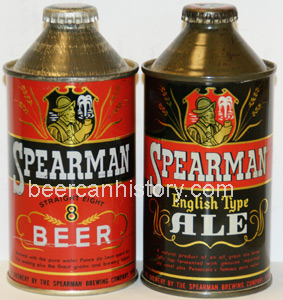
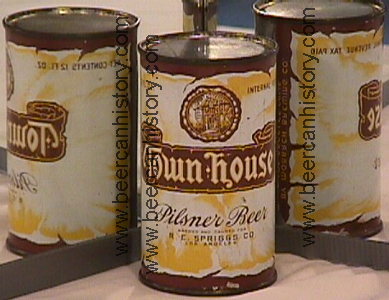
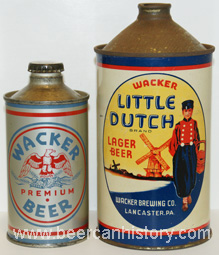
 |
 |
 |
 |
S is for San Francisco Brewing: (Sept/2011) In late 1936 San Francisco Brewing was the 5th largest brewery in San Francisco, located at 470 10th St. By the early 1950's, led by its popular Burgermeister Beer, it and General Brewing were the two largest breweries in San Francisco. In 1956 the name was changed to Burgermeister Brewing, and a few years later in 1961, the brewery was sold to Schlitz. Over a 25 year interval, the Burgermeister label was updated from its classic style 1930's Beer and Ale designs in following years, by a sequence of cans with a younger-looking man shown. A Lucky Lager employee in the 1970's said the youngest man's image on the last two cans, was a modeled after Burgermeister brewery employee at the time who lived in the Richmond district. |
Of the cans pictured, the 1930's Beer and Ale cans in on-grade condition are moderately scarce, but the other labels are common except for the 10oz can of which very few are known in on-grade condition. The can pictured was collected by Wally Gilbert in the 1980's. Per Ed Scoglietti (an active beer can collector with the website, oldbeercans.com), a few examples of the 10oz size have been dug in Alaska, and another example was found among a large group of Burgermeister Beer cans in the Markleeville, Calif. area (Carson Pass.) |
 |
| Besides its Burgermeister brand sequence of 12oz cans, quart-sized cans with the 1930's Beer and Ale label were filled, and in the mid-1950's another quart label was sold that matched the beer brand at the time. The brewery also sold beer in a number of secondary or private label 12oz cans such as Wilshire Club Beer and Ale, Brau Haus, Pilsengold. Alpen Glow, etc. - see W is for Wilshire Club Ale. The rarest quart from the brewery is the metallic Golden State Beer. On grade examples of the Golden State quart are scarce and have been located in the Reno, Nevada area and in Oregon State. Off grade examples have been found in several locations around California and in at least one other state. Top |
|
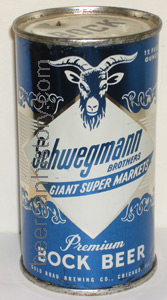 |
S is for Schwegmann bock: (Sept/2011) Schwegmann was a grocery store chain in New Orleans which had several brands made by a Chicago brewery, the rarest being Schwegmann Bock. Some "rolled" examples have been assembled and possibly 6 or more are in collections. Two cans were picked up by Bob Myers at a Schwegmann store on Rt 90 going east out of New Orleans in December, 1961; at that time in the middle of an aisle was a large pile of Schwegmann bock cans in cases, 5-6 high and several wide extending back 10 feet or so. The example pictured is one of those two cans with the other one going to Will Anderson who sold it with his collection around 1982. Top |
S is for Sheridan Beer: (Sept/2011) While found in dumps in the Wyoming and Montana area, examples with full colors are scarce and this can was one of 4 found in early 2000 by a worker looking for scrap metal in the crawl space under the Armory in Lander, Wyoming. For an oddity of apparently unrelated timing, he found them just before an article on Sheridan was published in the BCCA magazine. Top |
| S is for Silver State: (Sept/2011) This brand was seen by most collectors for the first time at the 1974 Denver Canvention and was among the cans Clay Tichelar found in the Bensonville, IL cone collection. Since that time another 4-6 fairly good shape examples have been found, along with dumpers. This can was traced back to a Chico, Calif. bar collection of cones and flats acquired by Randy McMahon, which had been bought from an original collector, whose name is now unknown, around 1970. Top | |
| S is for Some Thoughts...On the Beer Can's First 35 Years: (Jan/2021) Top |
 |
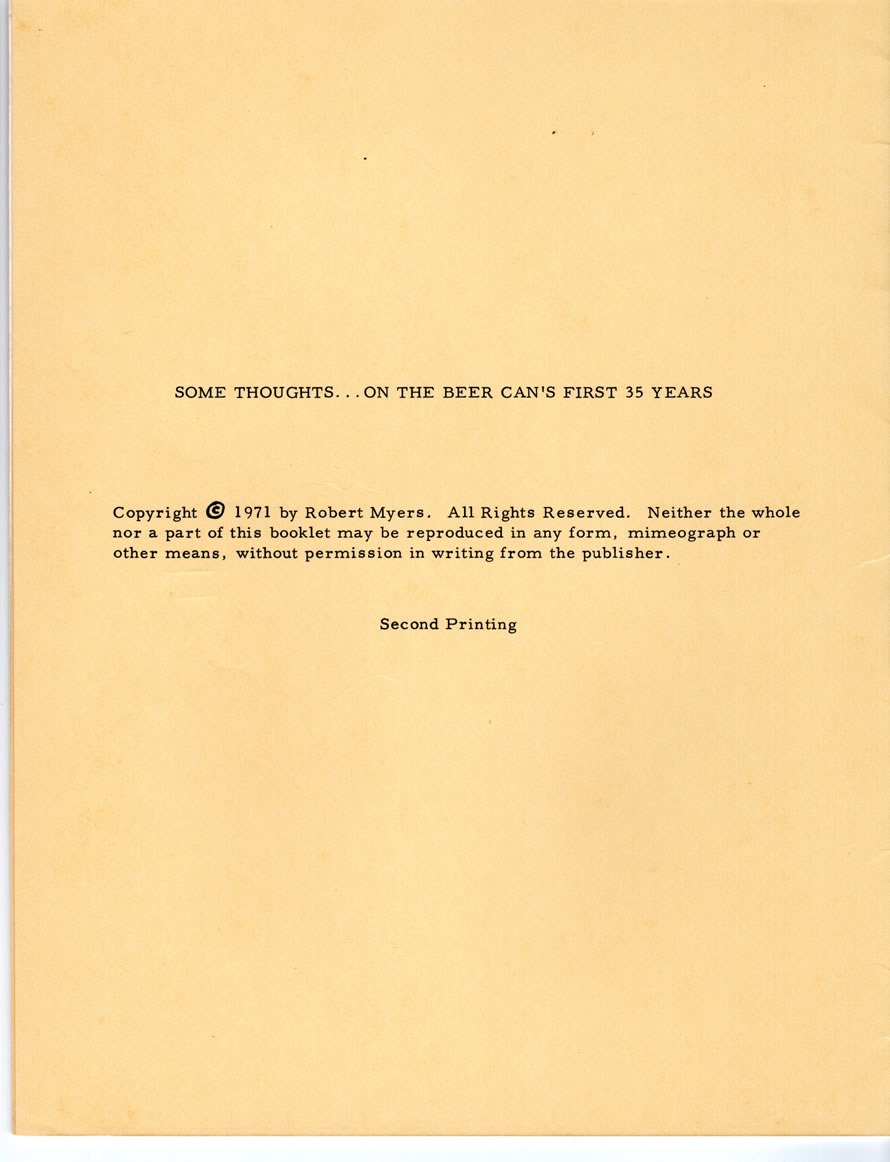 |
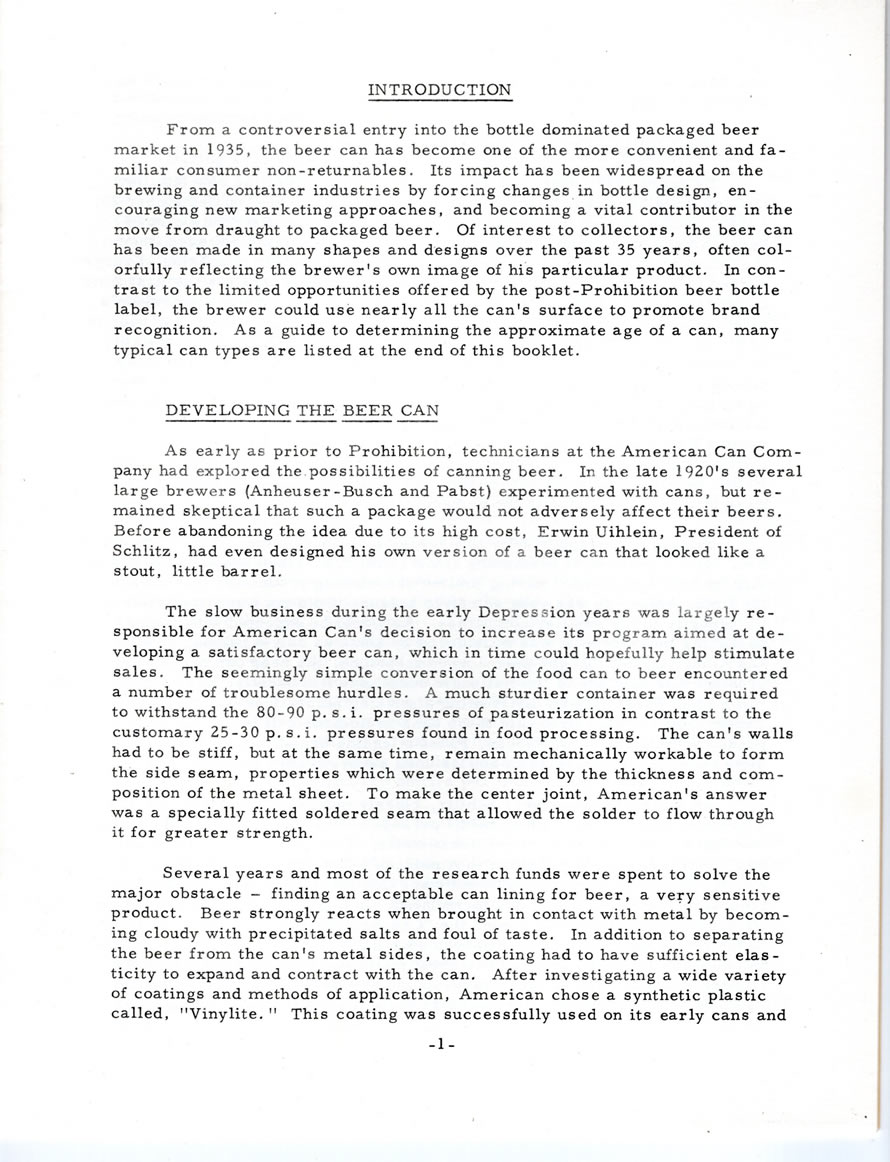 |
 |
 |
 |
 |
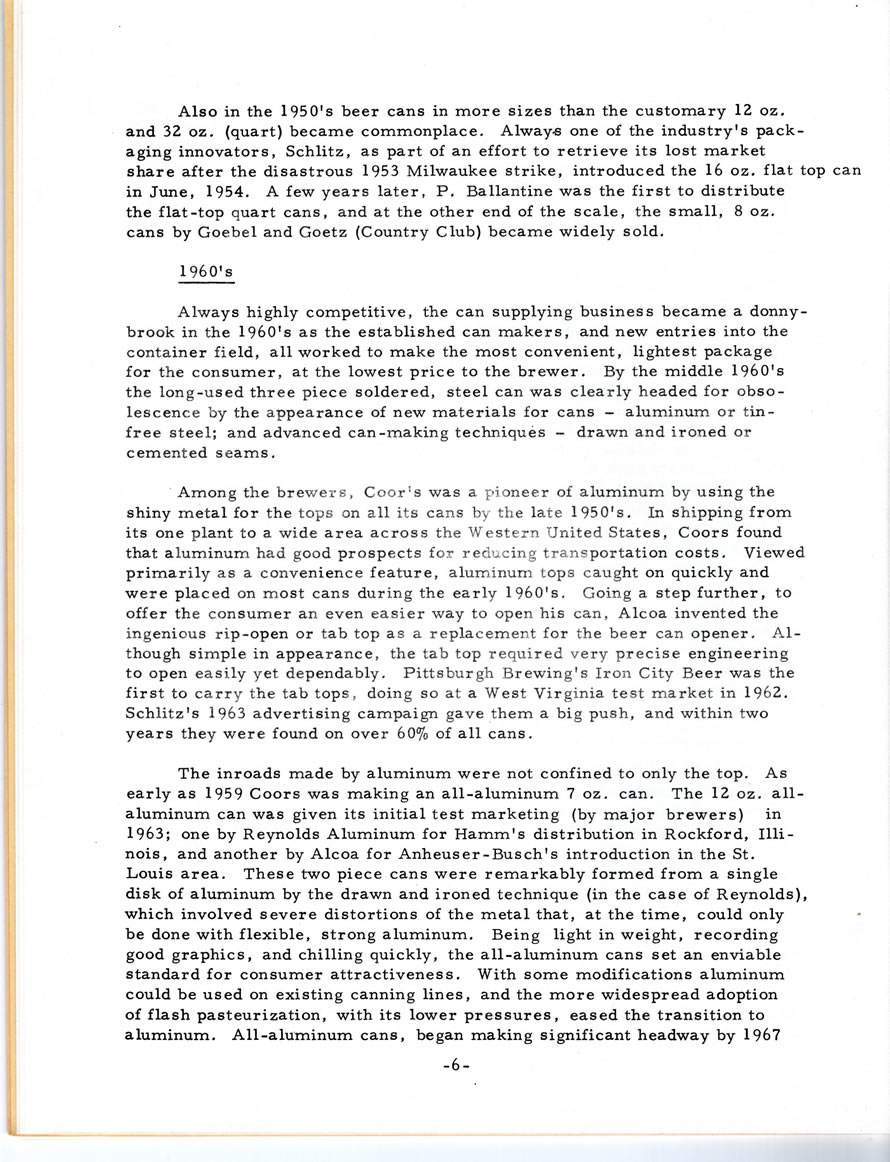 |
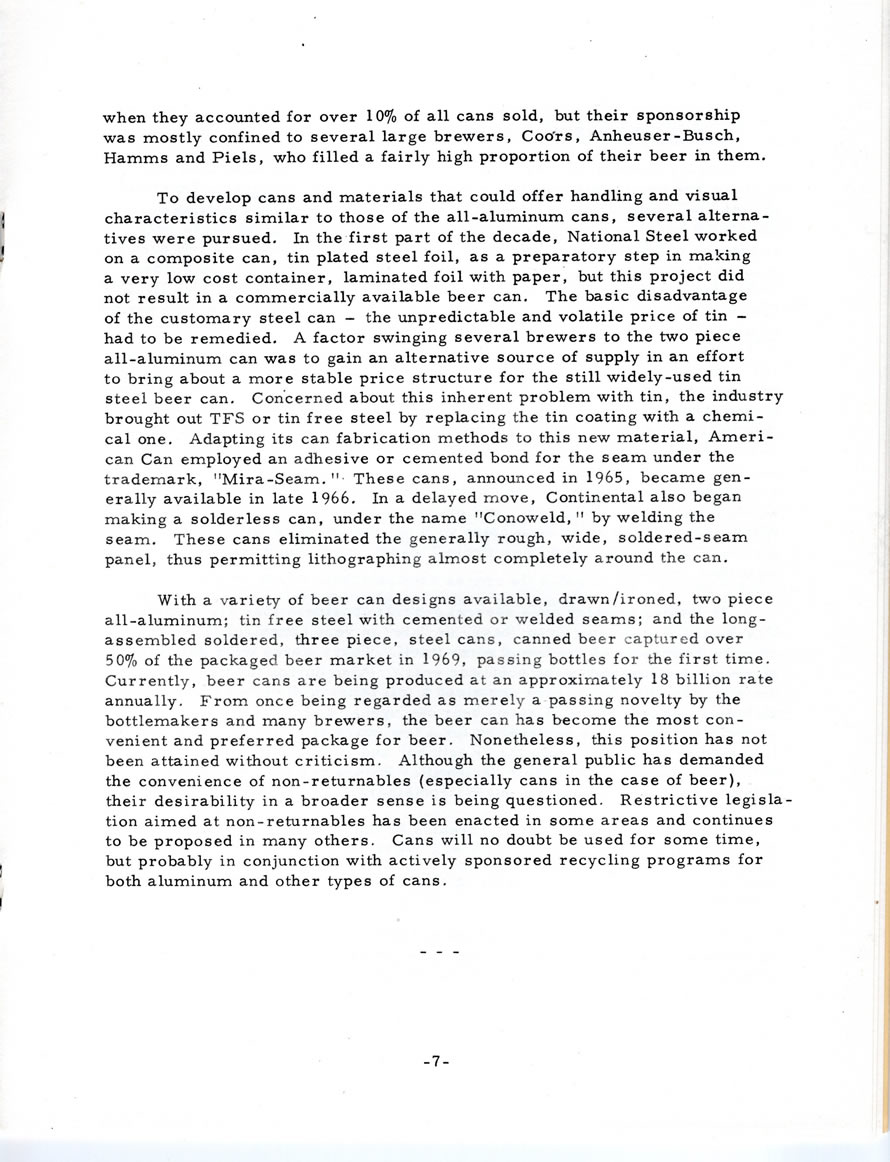 |
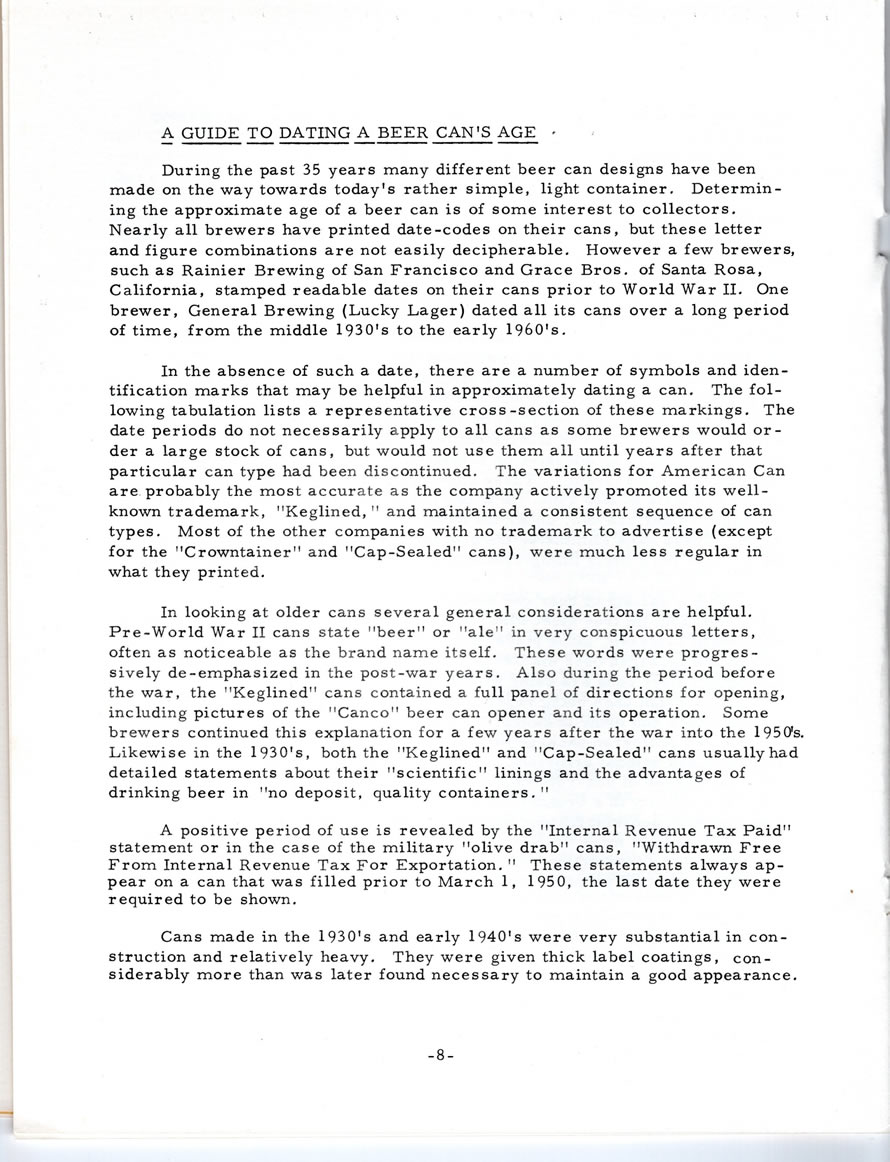 |
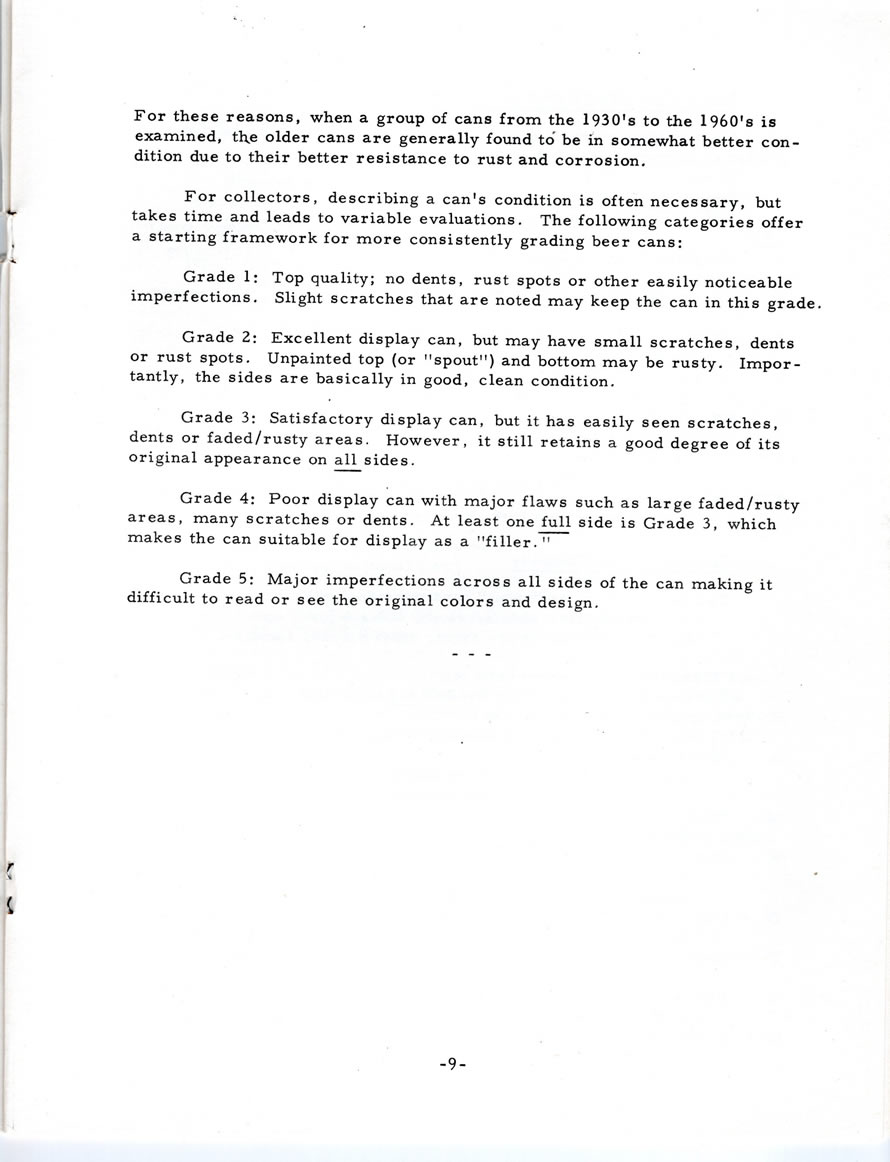 |
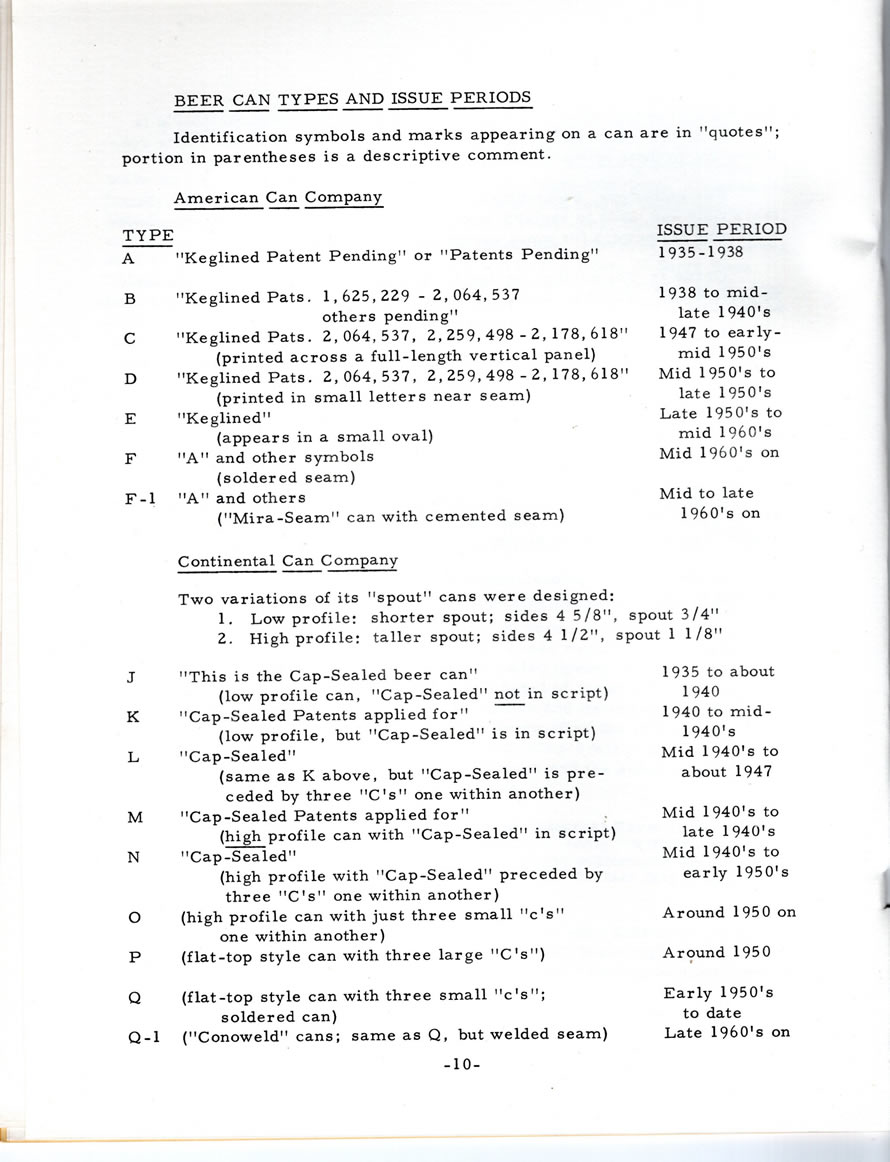 |
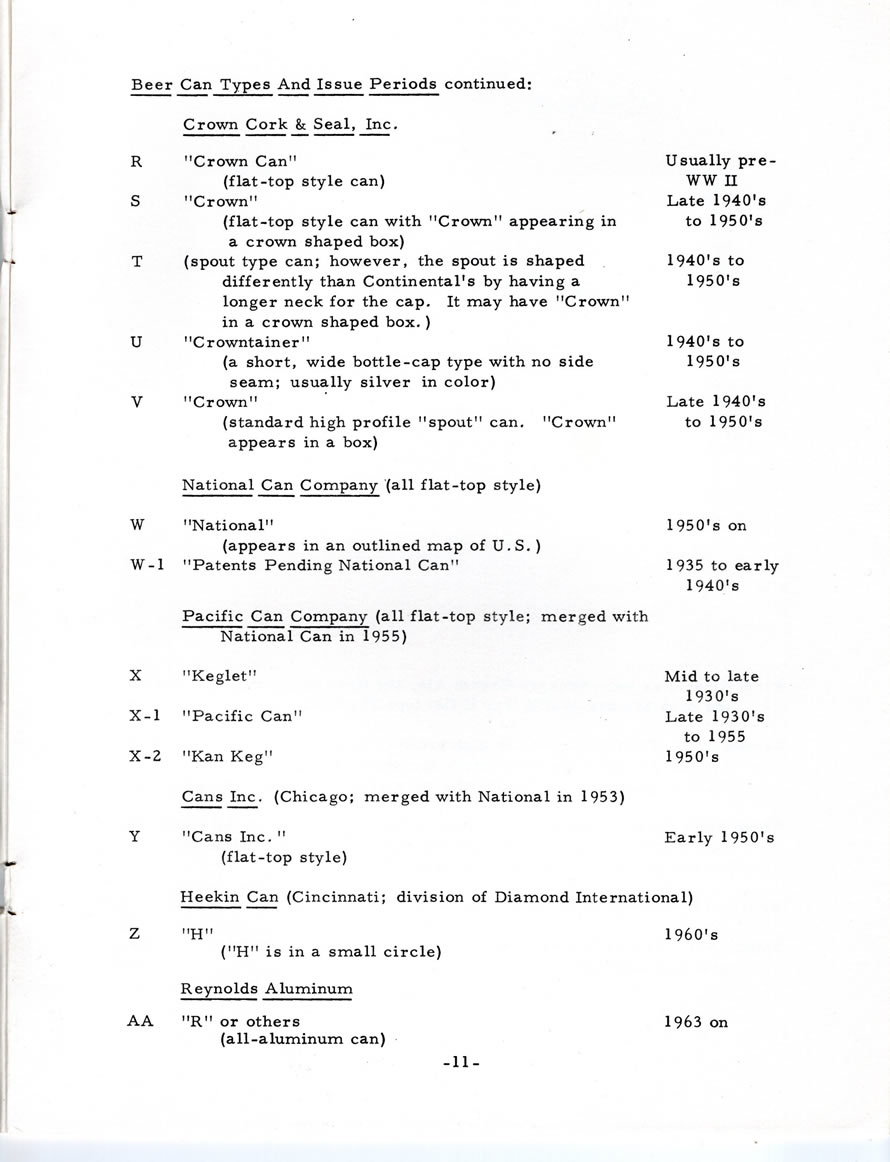 |
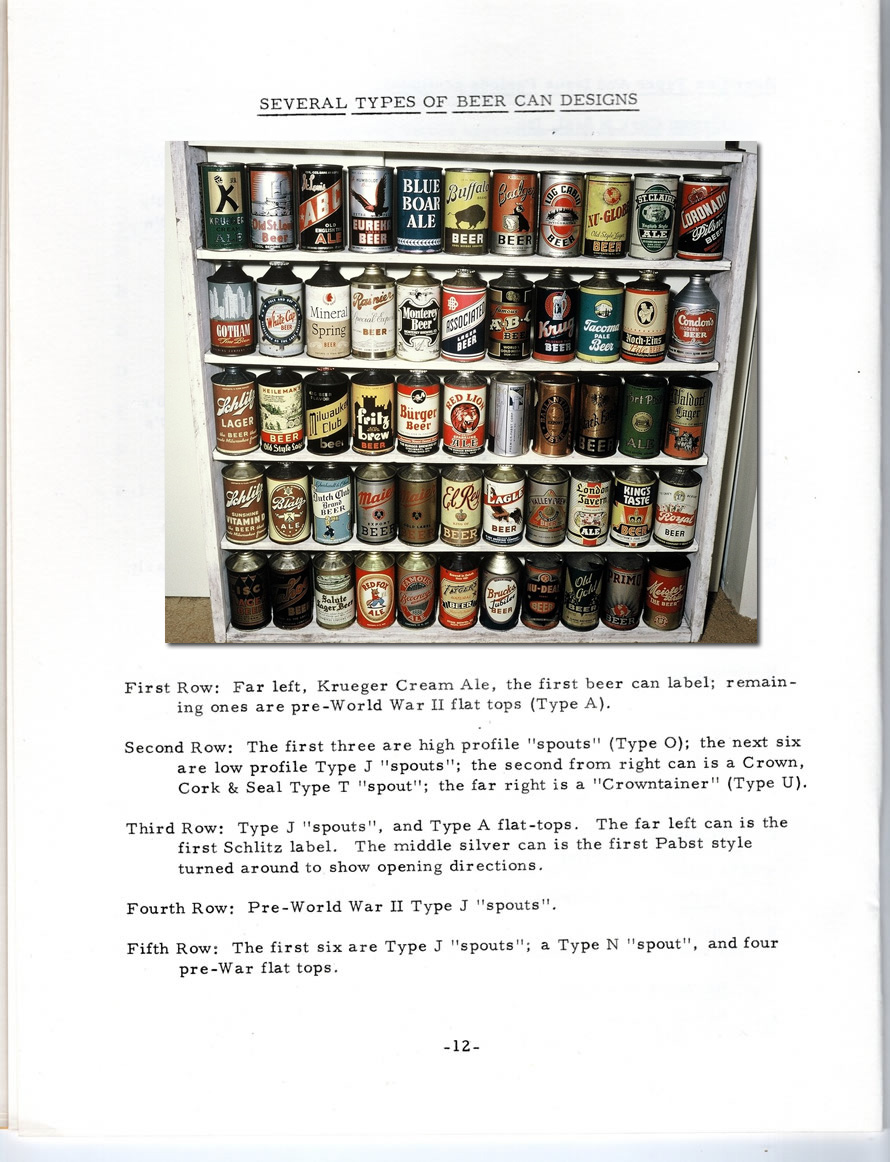 |
| Related Article, based on booklet, by Modern Brewery Age, April 5, 1971: |
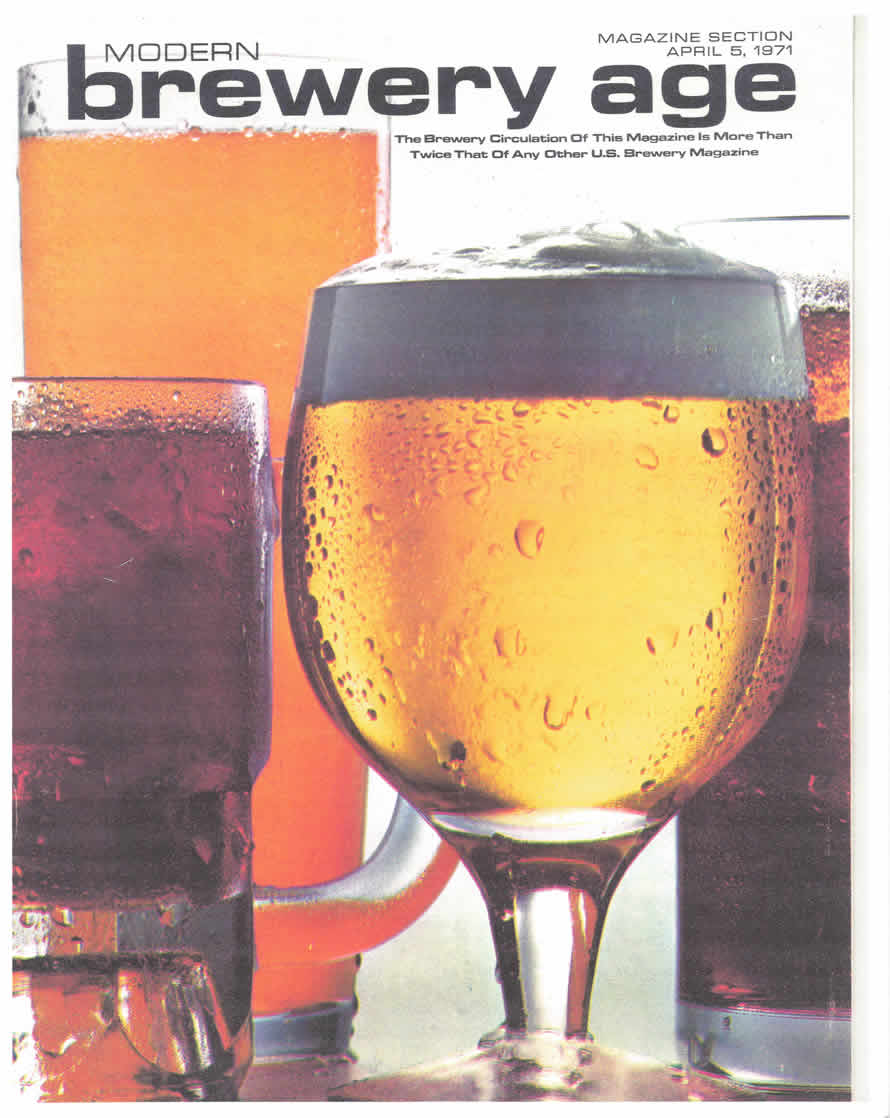 |
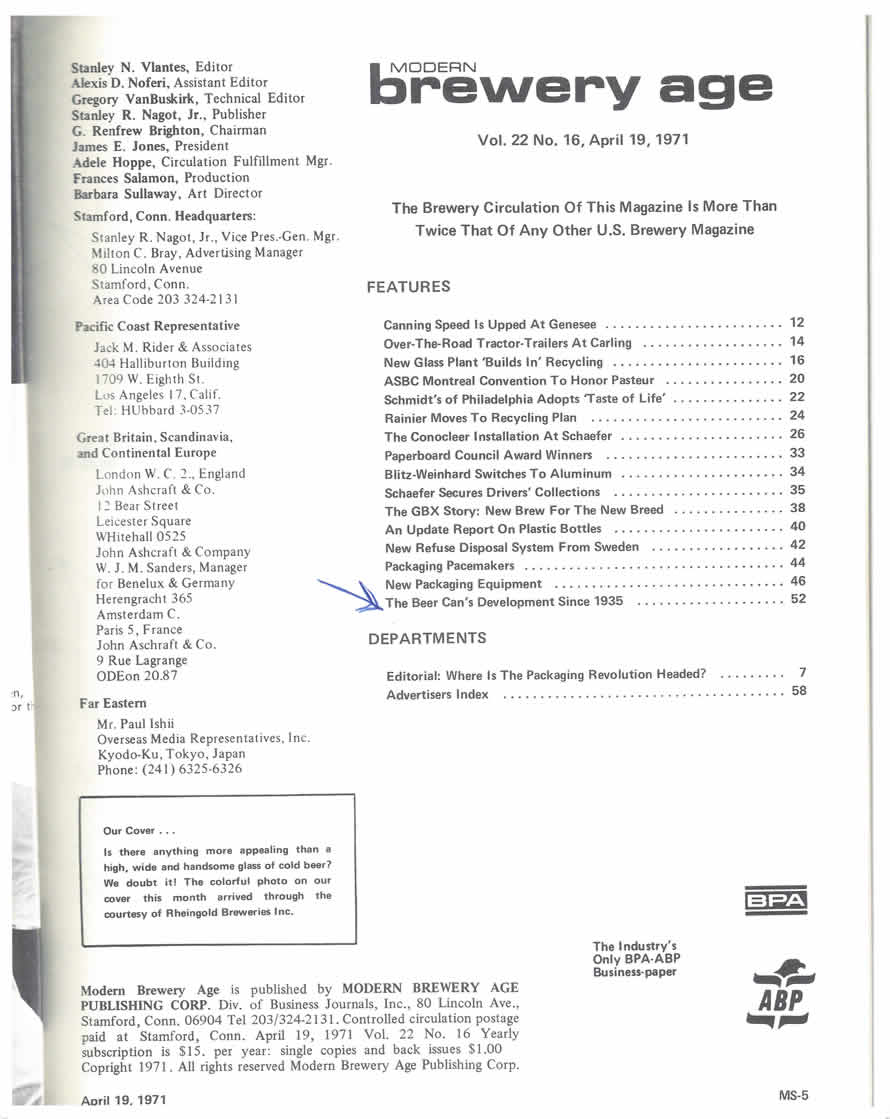 |
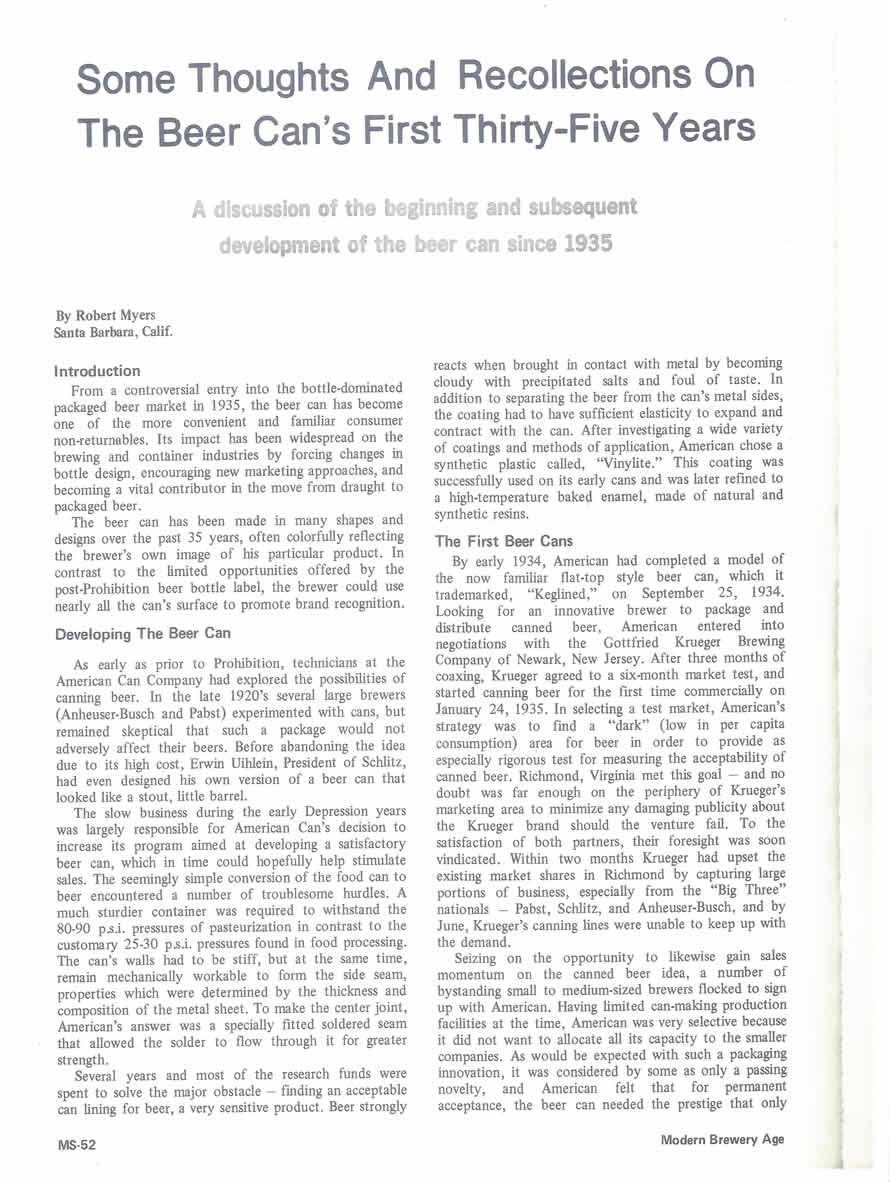 |
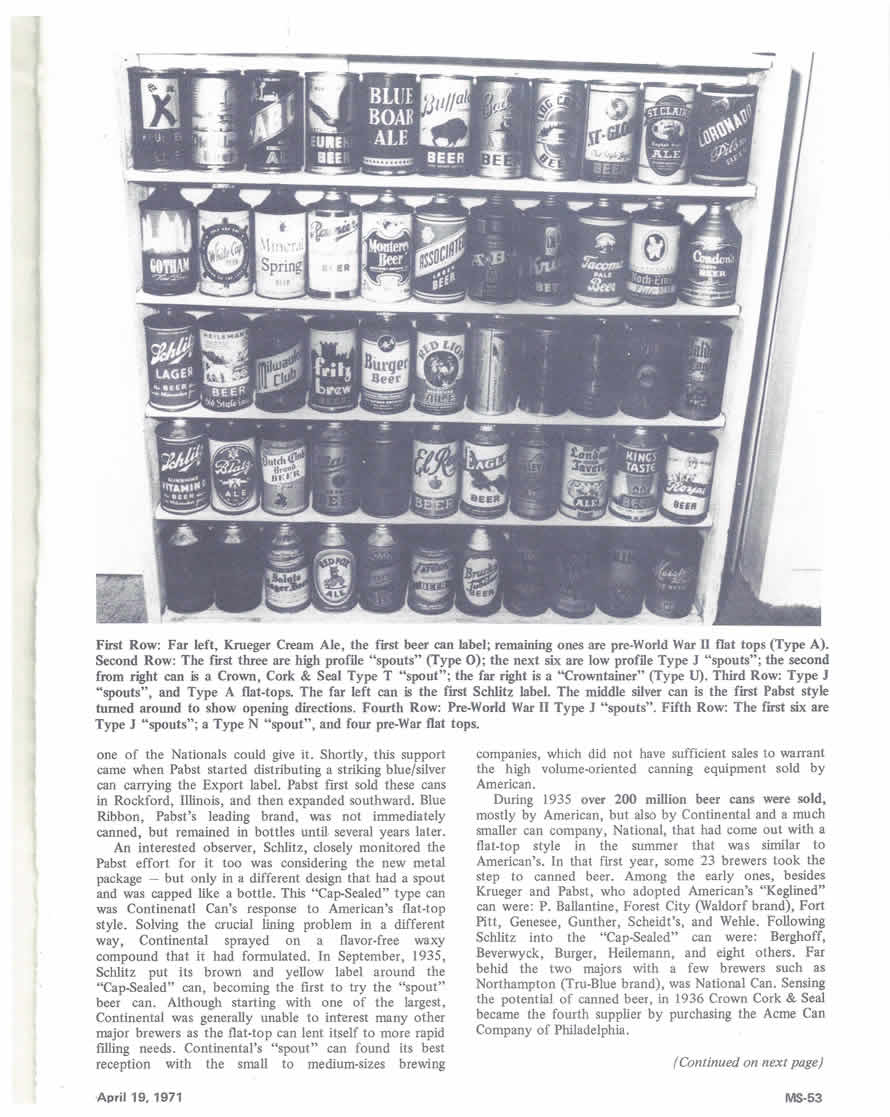 |
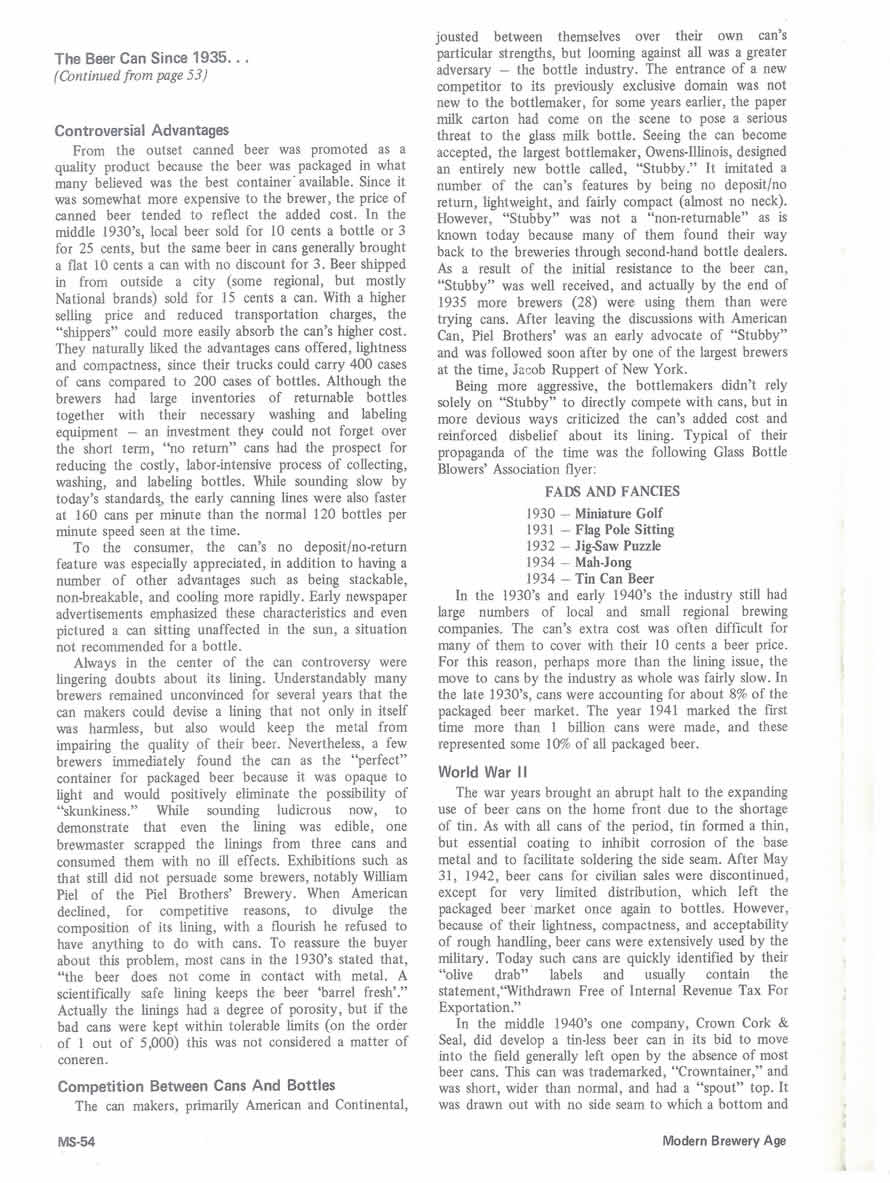 |
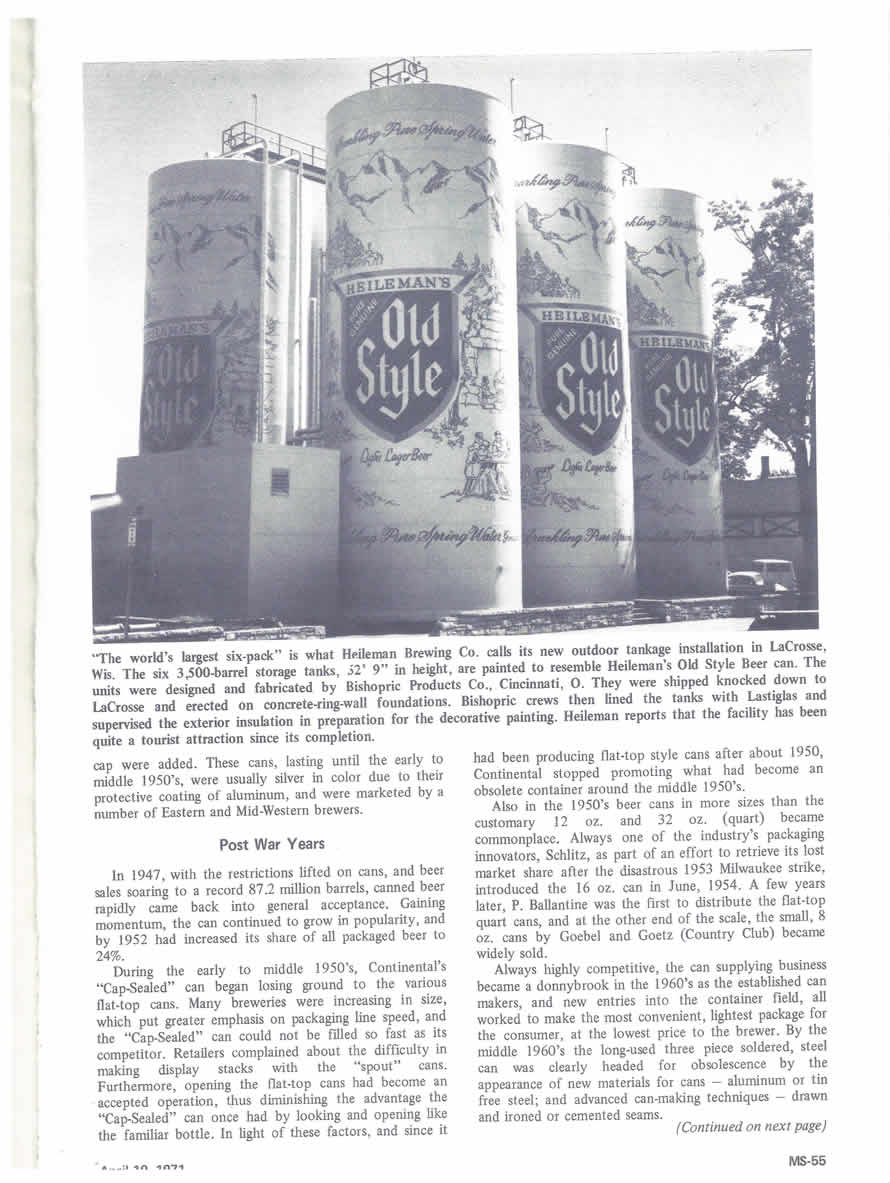 |
 |
 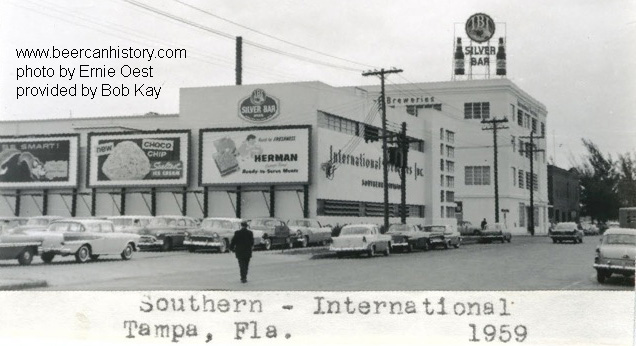 |
| S is for Southern Brewing Co., Tampa: (June/2012) In Tampa, Florida this brewery canned beer from the later 1940s to 1956 when the brewery plant became part of International Breweries, Inc. The SB cone has been scarce in top shape due to its metallic label and this example was picked up by Dick Caughey in the early 1990s from Fred Goodhart of Lexington, Virginia. The Silver Bar Ale high profile cone started a group of different labels under that brand, including a flat top can having a similar label, and then later variations. Silver Bar Lager Beer was started in the earlier 1950s with a striking black can showing a silver bar across the label. There also was a series of Silver Bar Lager cans having different colors, a marketing approach that was done by a number of other breweries for brands such as Blatz, Drewry's, GB, etc. These cans, each given a different color, have been called, "Fads of the '50's," a term coined first by John Ahrens BCCA #9. Top |
| S is for Spearman Beer and Ale cones: (Sept/2011) The Spearman Brewing Company of Pensacola, Florida started with the two cones pictured in the late 1940's. The rarest cone has been the "Draft Beer", one of which reportedly was located around 1980 in a small 40 can collection by Craig Hasslinger of Baltimore and Ken Hostetter. Top |
 |
S is for St. Claire Beer and Ale: (Sept/2011) A small brewery in San Jose, Calif. that discontinued business in 1939, which also had a number of other brands, Old Gold, Pilsenbrau, Steinbrau, Black and White, etc., that were used later by other Calif. breweries. Top |
| S is for St. Louis ABC Old English Type Ale: (January/2014) The name "A.B.C. Brewing Corp., St Louis, Mo" is printed on this St. Louis ABC Old English Type Ale beer can with opening directions. That brewery name and a variation are shown on St. Louis ABC Beer cans, as well as on other brands, Old St. Louis Ale/Beer.
St. Louis ABC Old English Type Ale OI cans have been found in limited numbers on-grade and in dumps. For on-grade examples, there may be 3 or more and the provenances on two have been documented: |
|
A second example of the St. Louis ABC Old English Type Ale beer can has been known to have been held by a man whose family had a beer distributorship in St. Louis and he told persons that he understood the Ale can was picked up at the brewery. In the American Brewer Magazine 11/36 issue, a press release by American Can Co. listed breweries across the country that were using Keglined beer cans as of 10/28/36 (per information given in a 2/21/2009 Rusty Bunch website comment on Keglined cans.) In those listings was "A.B.C. Brewing Co. St. Louis, MO", but due to conflicting later information, how long and what brands were canned at that location has led to varying opinions among some collectors. Collectors who have researched the subject have found the ownership of A.B.C. Brewing had some connections by ownership and management persons with Manhattan Brewing in Chicago. The name "A.B.C Brewing Co." closed in 1939 per: "The Post-Prohibition Brewery Guide 1933-1983 by Jody Farra and Phil Myers, but other sources have found the closing date was in early 1940. Top |
|
S is for Stegmaier Ale low profile cone: (January/2014) The Stegmaier Brewing company in Wilkes-Barre, Pennsylvania was a major regional brewer with a long line of beer packaging in 12oz cones and quart sizes, plus a line of 12oz flat top beer cans in the 1950's, 1960's, and into the early 1970's. Traditionally the Stegmaier Ale cans in the quart size with their "classic 1930's" solid red/green colors have been scarce but 12oz low profile Stegmaier Ale cones were even rarer, with only a few examples seen approaching, or above, grade 1. Then around 2009, hundreds of 12oz low profile Stegmaier Ale cones in good to passable condition were found, often with full colors, reportedly not too far NE of Wilkes-Barre along a stone wall at what has been called the "School House dump". |
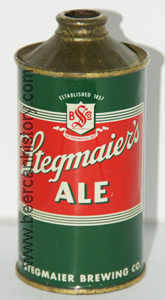 |
|
|
As Dave Lang described in 2013: "The Stegmaier Ale situation reflects the changes in rarity that a significant dumping find can make for a highly desirable can. I’m only aware of the one large find in PA but that find resulted in hundreds of L/P cones becoming available and many were in quite good condition. Before the find, a decent off-grade L/P" (edited to condense)was elusive, "when I first got an example, it was one of the few I’d ever seen available. I’m told the cans were found directly behind a stone wall and the L/P Stegmaier Ale was basically the only brand in the dump. I think it remains as the only decent find of the can." The full-colored 12oz. Stegmaier Ale low profile cone pictured was found in an attic sometime after 2005. During the 2007-8 time frame, Keith Belcher, BCCA member, recalls seeing an on-grade "high profile" Stegmaier Ale cone at a show, but there is uncertainty on how many of those are around. The former Stegmaier Brewery Brew House is now the Stegmaier Federal Building and is one of the better examples of a former brewery building in Pennsylvania having its exterior walls preserved and "recycled" to another employment use. Among the many persons, collectors, and groups highlighting the advantages of saving at least part of the historic brewery complex have been Breweriana collector Al Kogoy, brewery historian Rich Wagner, and Breweriana groups ABA and ECBA that have had conventions in Wilkes-Barre bringing attention to the Stegmaier Brewery's role in Wilkes-Barre history. Top |
| S is for Stroud Beer and Ale: (Sept/2011) These two cans from National Can Company were sold by a short-lived, very small brewery in Stroudsburg, PA that operated during 1935-1937. On-grade and dumper examples are always a highlight for collectors to find. On-grade examples exist in limited numbers with the rarest variation thought to be the Beer pictured that has "Distributor" and the address "2 W. 45th St., New York City" - a 1910-era office building located in Midtown Manhattan just off 5th Ave., which indicates the Brewery was trying a high-quality marketing approach. For a very small brewery, an architecturally interesting building. Top |
|
 |
|
 |
T is for Tahoe Beer: (August, 2017) Carson Brewing Co operated from 1933 to 1947 at King and Division Streets in Carson City, Nevada. In the later 1930s, when the brewery had a listed capacity of “5,000 barrels,” it was one of the smallest breweries to include a canning line.
The Tahoe Beer low profile can has been found around grade 1, and in lesser conditions, but is scarce in grade 1/1+ and better. Probably the main source of around 3-5 top condition examples were from a bottle collector who would visit the Reno Bottle show in the 1990s, per Jack Riesselman. Over several years, the bottle collector would bring one full/pristine example for sale, and the last one offered was much lesser shape. Typically with such finds, the bottle collector didn’t provide background info on how the few examples were saved, but likely someone in the area had saved a few of the cones when currently being sold and preserved them very well. Ernie Oest when making his trip to see California breweries in 1961, included visiting Carson City taking the photo below of the brewery. Top |
  |
|
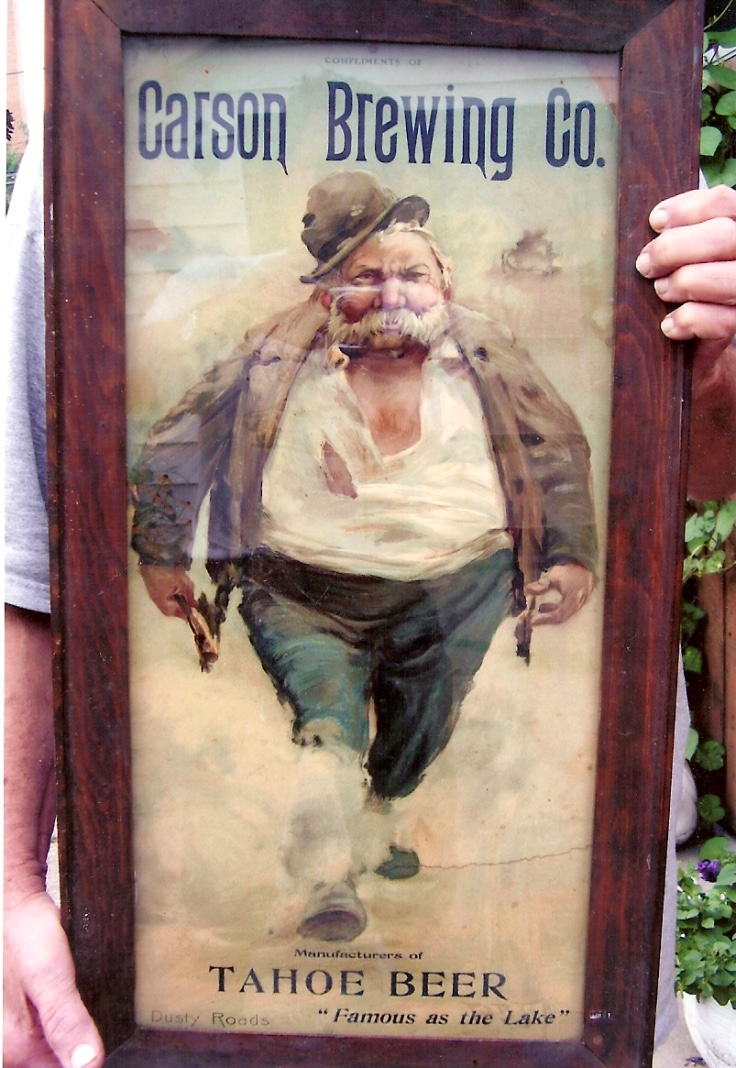 |
|
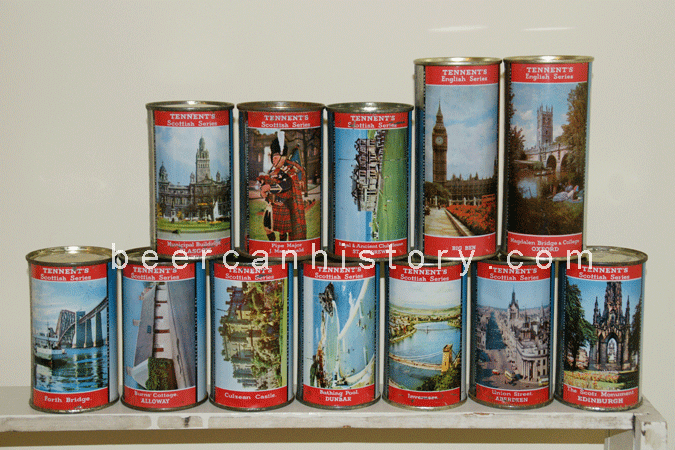 |
T is for Tennent's Scottish and English scene cans: The Brewery is best known among collectors for its many different series of "beer can girls" that were started around 1964. However earlier, during 1959-1964, the brewery started the idea of using photographs on cans by having a series of Scottish and English "scene" cans. Eighty or more scenes were done on cans for several types of beer, lager, stout, etc., and in two sizes, 12 and 16 oz. For the first group of scenes, marketing persons at the brewery went to the Scottish Tourist Board and picked up 20 different photographs - "20" was the number picked since the Medal Box Company printed beer cans in sheets of 20. |
| Many of these cans were exported and have been found discarded on and around British Army bases such as in Cyprus where reportedly around 400, mostly 16oz size ones were found in the 1990's. These 12oz. "scene" cans have been relatively scarce, but have turned up in Argentina and were sold (per Rawley Douglas) in San Francisco at Ghirardelli Square. A number of these cans have a distributor's address on Balboa St. A 1984 book, Lager Lovelies by Scholfield and Kamm, detailed the many different Tennent's cans. Top | |
| T is for Tornberg's Old German: (Sept/2011) from El Rey Brewing San Francisco in the late 1930's. ("Tornberg" may have been the name of a pre-Prohibition brewmaster in San Francisco who worked at several breweries.) Two examples in different conditions for this brand are shown as a pairing that could be done with nearly all the beer cans on this website. One example is in "on-grade" condition; the other is in the category of an "under-the-house" or "off-grade" can. Since photos need to be limited, most cans pictured are "on-grade" cans to show as possible the original colors and design, which is the typical approach when assembling pictures of coins, stamps, etc. |
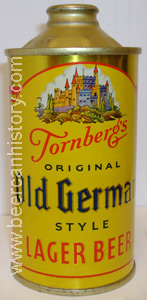 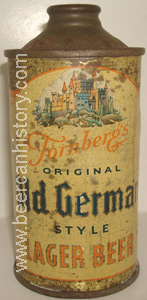 |
| Importantly however, from a beer can collector's perspective both cans are collectible and are essentially equal, since either one would serve well as an example of this brand. ----- (From a non-collector seller's perspective, an on-grade example usually has an advantage of selling at a higher value - when a buyer is found.) While the on-grade Tornberg's shows some colors and words better, the "under-the-house" category can has an advantage that it is an "authentic" beer can since it was found discarded with other beer cans that are known to have contained beer. There can be an uncertainty with some "on-grade" cans if they contained beer or not. Many collectors only collect "authentic" beer cans that have been dug or found discarded to avoid ending up with "test" or other types of fabricated cans that likely didn't hold beer or were sold to the public - for those cans that they didn't buy in a store or know someone who bought it. This "off-grade" example was located by Gene Dicicco in the 1980's. In response to a newspaper ad, a roofer contacted Gene about 10 cans found in an attic while reroofing a one-story commercial building in Watsonville. Besides the Tornberg's, among the other cans was an ever rarer can: the red/gold opening directions Lucky Ale. On-grade examples of the two variations of the Tornberg's Old German cones have been scarce with examples being found in the Clovis, Calif. collection with Associated paper label can, etc. and other groups since the early 1970's, such as in the Mercier "find". Off-grade examples have also been relatively rare, but have been dug in various locations around Northern Calif. Top |
|
|
|
T is for Travis Dark Beer and Travis Beer: (Sept/2011) Two brands from the Sabinas Brewing Co. in San Antonio, Texas, which operated from 1934 to 1938. Sabinas Brewing was one of the earlier brewers to can beer, and besides "Beer," the other brand included the word "Dark". "Dark" has been seen on other beer labels, and sometimes the German name was used directly as a brand, Dunkel Brau. Until more information is developed, the likely individualistic taste of the Travis "Dark" may not be known. Typically "dark" has been a generalized category that could include Bock, Stout, and Porter, or referred to creative steps and ingredients that an individual brewmaster used with deeper colored malt, roasted malt, even honey, etc. Both of the Travis low profile cones are scarce in on-grade condition and from dumps, with the "Dark" variation being by far the scarcer of the two. The Clay Tichelar collection had one of the first on-grade Travis Beer cones that became known to collectors. Top |
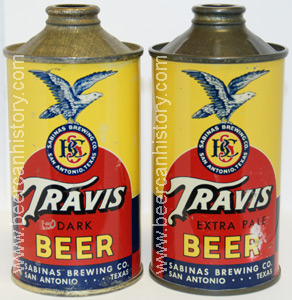 |
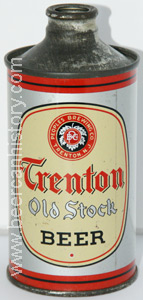  |
T is for Trenton J: (Sept/2011) "On-grade" Trenton J's known in collections by J spout specialist Marc Tracy: |
---A Trenton J was brought to a 1980's BCCA Canvention by a New Jersey collector who had found it at a flea market. Dick Caughey and Tom Waggoner "flipped" for the cone, with Tom winning the can and keeping it for some years until trading to an Eastern collector. ---A 3rd, and a lesser on-grade example, was offered for sale in summer of 2009 by Breweriana.com. Earlier it had been displayed for some years at Wilson's Auctioneers and Appraisers in Chester Heights, PA, who sold it at the end of April, 2009 along with the 3rd Class can. |
|
U is for Utica Club Famous Sparkling Ale: (Sept/2011) Two examples of this, rarer "high profile" variation, were found by Bob Myers and Will Anderson in an abandoned house south of Tupper Lake in the 1960's, plus scattered others have been found and were in collections. Top |
 |
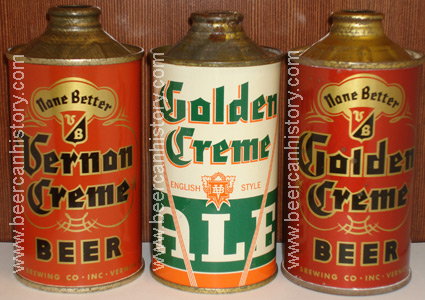 |
V is for Vernon Brewing Company: (Sept/2011) In 1936 the Vernon Brewing Company was ranked 14th in production of around 32 breweries in California. In the October 1998 BCCA magazine, Dan Andrews described the brewery as having a smaller sized plant, 25,000 barrels, and early-on was marketing three labels in beer cans: Vernon Creme Beer, Golden Creme Ale, and Golden Creme Beer. All three labels are very rare in on-grade condition and only lesser seen in better off-grade conditions. As has been found in other metropolitan areas of the country, one reason for the rarity of beer cans produced by "big city" smaller breweries is that when the cans were distributed locally, they typically were discarded into "big city" dumps that are now long covered over. |
| Vernon Creme Beer: One on-grade example was in the Mercier collection, and Dick Caughey found another one, but the brewery's small size has resulted in few on-grade examples being found. Scattered off-grade examples have uncovered occasionally. | 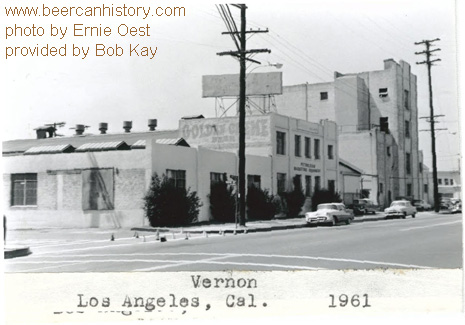 |
| Golden Creme Ale: One "under the house" grade example was among the many other beer can brands found by Wally Gilbert in his 1971 Wagon Wheel dance hall "find", and the can is pictured in Ressel's Beer Cans Unlimited book. An on-grade example of Golden Creme Ale was part of the "Army Officer" collection found in 1984 by Tom Leo and Dick Caughey; in 2001 another on-grade example was sold by an antique dealer in the San Gabriel Valley. This example reportedly had had a paper label on it, as the can had been "recycled" to hold another product. In off-grade condition, some of the best dumpers have been found by Ed Scoglietti. Golden Creme Beer: Among the first examples of the label were found in the 1970's by Dale Bramlette of Bishop, Calif., but other examples have been scarce. In the early 1990's, three on-grade examples reportedly were found in Riverside and bought by Dan Andrews. He held the can pictured until he died; Dan was well known for his collecting camaraderie, and contributions of many BCCA articles on breweries and beer can history. Top |
|
| V is for Valley Forge Bock: (Sept/2011) An opening direction variation of one of the longer lasting bock brands from 1930's to 1960's. Top |
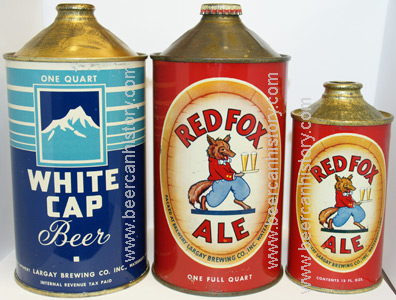 |
W is for White Cap and Red Fox Ale: (Sept/2011) Largay Brewing in Waterbury, Connecticut was run by George Largay and the brewery is well described in Beer New England by Will Anderson. Before Prohibition George Largay had been a brewmaster, and as written by Will Anderson: "Prohibition gave George Largay a good chance to reflect... and to realize that he'd like to operate his own brewery." This yearning to start a brewery was common among many Pre Prohibition brewmasters by the early 1930's, and a number of them did start breweries, even though they were often in their 60's. (Another such brewmaster, owner of the Delatron Brewery in Reading, Ohio - London Bobby, Gotham brands were canned, will be described by Robert Musson in his next book on Ohio breweries.) | |
| George Largay purchased the former Hellman Brewery in Waterbury. He picked "Red Fox" for a brand partly as a result of his hunting interests and respect for the animal - a name that connected with the snappy slogan: "Just what you have been hunting for". ("Red Fox" as a brand wasn't new to New England; as Ken Ostrow found, it was used by a Massachusetts brewery before Prohibition.) |  |
|
| Largay Brewing expanded to a capacity of 150,000 barrels and the Red Fox brands sold well for a small town brewery, but especially after World War II, George Largay saw the building cost pressures from having to compete with the advertising economies of scale gained by the large regional's and the unending supply of beer and ale being sent ("dumped in Connecticut"?) by the New York City breweries. In 1947 Largay's brands and equipment were sold to Ruppert, which canned the Red Fox label in it's short lived Norfolk, Virginia brewery. The architecturally interesting Waterbury brewery building was later torn down, "replaced" by an apartment building of routine design. For Largay, the Red Fox Beer and Ale brands label were the main sellers, and were canned in 12oz and quart sizes. On what must have been a very limited basis, the White Cap label was canned in 12oz and quart size. The pictured White Cap qt. was originally in the Clay Tichelar collection that was part of the Bensonville, IL group saved by a photographer at Continental Can. The 12oz Red Fox Ale cone to the right was found, still in grade 1+ condition, in the attic of the Owls Head, NY railroad station by Bob Myers and Will Anderson. The bright and colorful Red Fox Ale cans have been found in only limited numbers, and remain one of the more popular designs for collectors. Top |
||
| W is for Wilshire Club Ale: (Sept/2011) Burgermeister Beer and Ale were the main labels of San Francisco Brewing at its South of Market 10th St. brewery. Mostly in the 1930's the brewery also had a number of other colorful labels, Alpen Beer Glen/Glow Beer and Ale, Brau Haus, Pilsengold, Willows, and Wilshire Beer/Ale. One of the rarer cans to dig is the Wilshire Club Ale. Only two of the Ale cans have been found by Dale Bramlette, which considering all the digging in California Dale has done over many decades, shows the Ale must have had limited distribution. A few limited finds of Ale have been made, such as Ed Scoglietti knows of 3-4 of the Ales, with "Keglined" on front, that were found in Martinez, Calif. However, in contrast to the usual ratio of many cans being found in off-grade condition for each on-grade example, 13 sets of the Wilshire Club Beer and Ales were saved as mugs by a former brewery employee. As described in an October, 2002 BCCA magazine article, these sets were uncovered by Gene DiCicco in the mid 1980's and most of the cans now in collections have been given a lid. Top |
 |
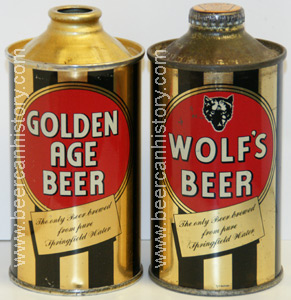 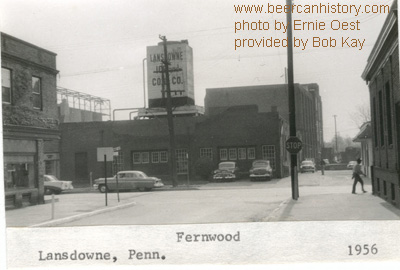 |
W is for Wolf's Beer and Golden Age Beer: (Sept/2011) These are the two brands in cones (also in quart size for at least the Golden Age brand too) produced by a small brewery in the suburbs west of Philadelphia. The Wolf's cone was found by Dick Caughey in the 1980's. The Golden Age cone was located by John Kretschmer who said it had been found in a row house in Washington, DC in the late 1990's by a renovator who saw three cans under the floor boards (also a Gunther IRTP flat top, and a low profile National cone.) Top |
|
 |
| [Back to Home] | |
| Copyright © 2007-2012 www.beercanhistory.com, All Rights Reserved. Last modified February 17, 2014. | |